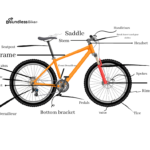Have you ever wondered how long it would take to bike 10 miles? Whether you’re an experienced cyclist or a beginner, knowing the answer to this question can help you plan your ride and make sure you complete your journey in time. Whether you’re looking to complete a 10-mile ride for leisure or exercise, this expert guide will provide all the information you need to know. With the right preparation and information, you can plan your 10-mile bike ride with confidence and start enjoying the journey.
Biking time Calculator V1
Introducing our new and improved biking time calculator! Whether you’re a serious cyclist or just enjoy a leisurely ride, our calculator can help you plan your next adventure. With our user-friendly interface, you can easily input the number of miles, terrain type, bike type and your own riding speed in MPH, and our calculator will quickly provide you with an accurate estimate of how long it will take to complete your ride.
How long does it take to bike 10 miles
| Speed | Terrain | Time to Bike 10 Miles |
|---|---|---|
| Slow | Flat | 1 hour 30 minutes |
| Moderate | Flat | 45 minutes |
| Fast | Flat | 30 minutes |
| Slow | Hilly | 2 hours |
| Moderate | Hilly | 1 hour 15 minutes |
| Fast | Hilly | 45 minutes |
On average, it takes about 45 to 90 minutes to bike 10 miles on flat terrain with moderate effort. However, the actual time can vary depending on factors such as the rider’s fitness level, the terrain, speed and the equipment used. A more experienced and fit rider will be able to bike faster than someone who is new to biking or not in great shape. To bike 10 miles in 45 minutes, you would need to maintain an average speed of 13.33 miles per hour (mph). To calculate this, you would divide the total distance (10 miles) by the total time (45 minutes) and convert minutes to hours (45 minutes / 60 minutes = 0.75 hours) 10 miles / 0.75 hours = 13.33 mph
Biking on hilly terrain will take longer than biking on flat terrain, and having a lightweight bike and proper gear can also affect biking time. A mountain bike will take longer than a road bike to complete the same distance, To reduce your biking time for 10 miles, you can train regularly, invest in a lightweight bike and proper gear, plan your route to avoid hilly terrain, and try interval training to increase your speed and endurance.
Factors that Affect Your Speed

To summarize the above point in details these are the main factors that will affect your speed
-
- Your Fitness Level: If you’re relatively new to biking, it will take you longer to travel the same distance as someone who rides regularly. The more fit you are, the faster you will be able to ride.
-
- The Terrain: If you’re biking in a flat area with no hills or obstacles, then you’ll likely be able to bike 10 miles much faster than if there are steep hills or obstacles in your path.
-
- Your Weight: Believe it or not, your body weight can affect your speed while cycling. Generally speaking, the heavier you are (assuming all other variables remain constant) the slower your speed will be when riding a bike.
-
- Wind Resistance: Riding on windy days requires more energy than riding on clear days because of wind resistance. So if there’s a lot of wind in your area, this could slow down your ride significantly.
-
- The Type of Bike You Use: Road bikes are typically designed for speed so they will help make sure that every pedal stroke counts and maximizes efficiency when traveling long distances like 10 miles. Mountain bikes have sturdier frames but are usually not as fast as road bikes due to their design.
On average…
- The Type of Bike You Use: Road bikes are typically designed for speed so they will help make sure that every pedal stroke counts and maximizes efficiency when traveling long distances like 10 miles. Mountain bikes have sturdier frames but are usually not as fast as road bikes due to their design.
Planning a 10-Mile Bike Ride
When planning your 10-mile bike ride, you’ll want to consider a few things, including the following: –
-
- Start with a shorter route
-
- Use a map
-
- Avoid riding a bike in the dark
-
- Pack a few essentials
-
- Wear the right gear
-
- When you’re new to cycling, it’s best to complete shorter routes.
-
- It’s important to plan your route ahead of time so you can avoid busy roads and hazards
-
- Cycling at night without proper lights and reflectors is unsafe.
-
- When you’re cycling for long periods, it’s a good idea to pack a few essentials, including water, energy bars, and a first aid kit.
-
- Make sure you’re wearing the right gear for your route, including a helmet, gloves, and a cycling jersey.
-
- If starting out 10 miles is tiring try out 8 miles first which is little easier
Training to Increase Cycling Speed
As you get fitter, your endurance, speed, and cycling capacity will improve. You can increase your cycling speed by training your legs to push harder on the pedals. To increase your cycling speed, you can try the following exercise: –
-
- Use a stationary bike at a gym.
-
- Using a stationary bike is a great way to train for cycling.
-
- Wear a weighted vest.
-
- Wearing a weighted vest will help you push harder on the pedals.
Equipment and Preparation
A few Equipment and Preparation need to cover the 10 miles.
-
- Use a bike that is the right size for you
-
- Use the best cycling gear for your climate
-
- Eat a nutritious meal before you cycle
-
- Hydrate before and during your ride
-
- Be aware of your surroundings
-
- Riding a bike that is too big (or small) for your body type will make cycling harder.
-
- A good helmet, cycling gloves, and waterproof clothing will protect you from the elements and help you cycle faster.
-
- Stay focused on the road ahead of you and be aware of your surroundings, especially if you’re new to cycling.
Safety Considerations When Biking 10 Miles
When planning your 10-mile bike ride, keep the following in mind to help you stay safe while cycling:
-
- Check your bike’s condition
-
- Wear a helmet
-
- Ride defensively
-
- Use hand signals
-
- Ride with traffic
-
- Make sure your bike is in good working condition before you set off on your journey.
-
- Wearing a helmet will protect you in the event of a fall.
-
- Always ride defensively and be aware of your surroundings so you can avoid hazards.
-
- Make sure you use hand signals when turning or stopping so other drivers and cyclists can anticipate your movements.
-
- It’s best to ride in the same direction as traffic so you can see approaching hazards.
Conclusion:
Now that you know how long it takes to bike 10 miles, you’re ready to start planning your journey. Cycling can be a great way to enjoy a scenic route, exercise, or commute to work. Start by selecting a route and making sure you have the right equipment, including a helmet and cycling gloves. Then, you can train for your journey by completing shorter bike rides, eating a nutritious meal, and staying hydrated. Finally, you can plan your route and share the journey with friends.






